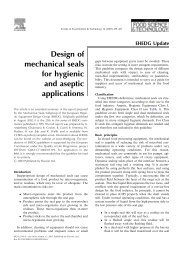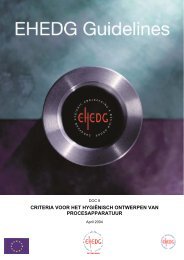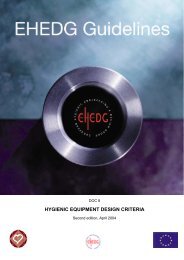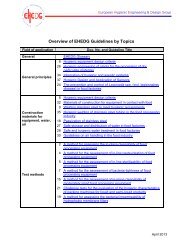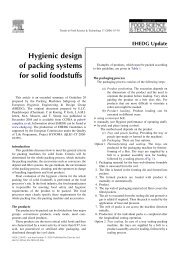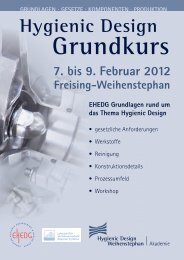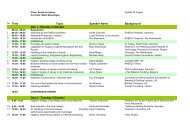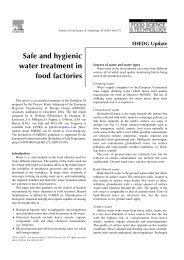Yearbook 2013/2014 - ehedg
Yearbook 2013/2014 - ehedg
Yearbook 2013/2014 - ehedg
You also want an ePaper? Increase the reach of your titles
YUMPU automatically turns print PDFs into web optimized ePapers that Google loves.
36 Particle and VOC emissions, chemical and biological resistance, and cleanability<br />
other cultivation test procedures. The efficacy of fungistatic<br />
or fungicidal coatings can be assessed on implementing<br />
Procedure B outlined in ISO 846. Fungistatic or fungicidal<br />
effects can be assessed if an inhibition zone is formed after<br />
application of the material sample to a fully-colonised Petri<br />
dish.<br />
Cleanability<br />
In order to assure hygienic processes and give products<br />
a maximum shelf life, adequate cleanability is generally<br />
necessary from a hygienic aspect. 23 A clean manufacturing<br />
environment is capable of minimising factors that could have<br />
a negative effect on sensitive products. 24 A standardised<br />
test procedure verifies the degree of effectiveness with<br />
which particles can be removed from a flooring system by<br />
wipe-cleaning. A linear wiping simulator is used to ensure<br />
reproducibility of the cleaning (Figure 7). Before being<br />
cleaned, test surfaces are reproducibly contaminated with<br />
a defined quantity of particles. Before and after the cleaning<br />
process, the concentration of particles present is determined<br />
by a measuring device that detects particles on surfaces<br />
(PMT Partikel-Messtechnik GmbH, Heimsheim, Germany).<br />
This enables the relative cleaning success of different<br />
surfaces to be calculated, and gives a comparative value<br />
based on standardised surface cleanliness classes. 9,25,26<br />
Figure 15 shows the results of a cleanability test on a<br />
material surface.<br />
Particulate emission<br />
The classification of particulate emission is based on the air<br />
cleanliness classes defined in ISO 14644-1 (Figure 8). 2 It is<br />
principally assumed that all particles generated by a flooring<br />
system as a result of tribological stress are released into a<br />
surrounding volume of air of 1 m 3 . 9 The ISO class calculated<br />
according to VDI 2083 Part 17 is, however, only a material<br />
classification value and cannot be directly correlated with<br />
the cleanroom class in which the flooring system can<br />
be implemented. To do this, the anticipated tribological<br />
stress also has to be taken into consideration. However,<br />
the material classification value established does enable<br />
the abrasion resistance of different flooring systems to be<br />
directly compared.<br />
Figure 8. Classification of air cleanliness in accordance with ISO<br />
14644-1. The classification of particulate emission behaviour from<br />
material samples is based on this classification..<br />
VOC outgassing<br />
Figure 7. Linear wiping simulator.<br />
Classification<br />
Classifications regarding particulate emission, outgassing,<br />
chemical and biological resistance, antimicrobial properties<br />
and cleanability are explained below in detail as developed<br />
by the industrial alliance CSM and standardised in the<br />
guideline VDI 2083 Part 17. The clear comparability and<br />
simple communication of information enables suitable<br />
materials to be rapidly selected according to their future<br />
conditions of use.<br />
To convert the SER value into an ISO AMC m class for<br />
the type of contamination concerned (in this case volatile<br />
organic compounds) the value is normed. The classification<br />
is based on ISO AMC cleanroom classes in accordance with<br />
ISO 14644-8 (Figure 9). 27 The actual detection limit is ISO<br />
AMC m (VOC) = -9.6. This material classification calculated<br />
in accordance with VDI 2083 Part 17 does not correlate<br />
with the corresponding ISO AMC cleanroom class. It does<br />
however permit the outgassing behavior of different flooring<br />
systems to be directly compared with one another. Based on<br />
the material classification value ISO AMC m , the anticipated<br />
ISO AMC class can be estimated if all relevant operating<br />
parameters are known (e.g., surface area, air-conditioning<br />
technology, volume of the manufacturing environment,<br />
etc.). 10,14



